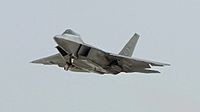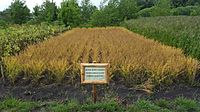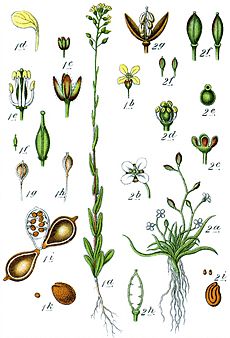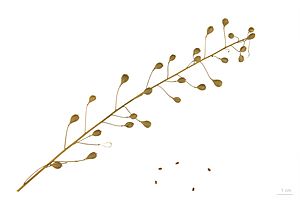Camelina sativa facts for kids
Quick facts for kids Camelina sativa |
|
|---|---|
 |
|
| Scientific classification | |
| Genus: |
Camelina
|
| Species: |
sativa
|
| Synonyms | |
|
|
Camelina sativa is a flowering plant often called camelina, gold-of-pleasure, or false flax. It belongs to the Brassicaceae family, which also includes cabbage and mustard. This plant originally comes from Europe and Central Asia. Today, it is mainly grown in Europe and North America to produce oil from its seeds.
Contents
What Does Camelina Look Like?
Camelina can be a summer or winter plant that lives for one year. It grows to be about 30 to 120 centimeters (1 to 4 feet) tall. Its stems branch out and become woody when the plant is fully grown.
Its leaves grow alternately along the stem. They are shaped like a spear, about 2 to 8 centimeters (1 to 3 inches) long and 2 to 10 millimeters (0.1 to 0.4 inches) wide. The leaves and stems can sometimes be a bit hairy.
In the UK, camelina blooms in June and July. Its flowers are pale yellow and have four petals, forming a cross shape. After flowering, it produces a pear-shaped fruit with a small tip. Inside are brown or orange seeds, each about 2 to 3 millimeters (0.08 to 0.12 inches) long. About 1,000 seeds weigh between 0.8 and 2.0 grams.
Where Does Camelina Grow?
Today, you can find camelina growing wild or on farms in most parts of Europe, Asia, and North America. It also grows in South America, Australia, and New Zealand. Camelina seems to grow especially well in cold, dry areas like steppes and prairies.
A Look Back in Time: Camelina's History
For thousands of years, Camelina sativa has been grown to make vegetable oil and food for animals. Archeologists have found proof that people in Europe have been growing it for at least 3,000 years. Some of the oldest findings are from the Neolithic period (New Stone Age) in Switzerland and the Copper Age in Greece. It was also found in Romania around 2200 BC.
During the Bronze Age and Iron Age, camelina was an important farm crop in northern Greece. It was also found in Denmark and Hungary during the Stone Age. It seems people continued to grow it during the Roman Empire. Around 600 BC, it was grown by itself in large fields near the Rhine River. It might have spread mostly by growing as a weed alongside fields of flax.
Until the 1940s, camelina was a key oil crop in eastern and central Europe. It is still grown in some parts of Europe for its oil today. Camelina oil was used in oil lamps before natural gas and electricity became common. It was also used as a cooking oil. Camelina likely came to North America by accident, mixed in with flax seeds. It wasn't very important commercially until recently. Scientists are still exploring its full potential compared to other oilseed crops.
How We Use Camelina Today
Camelina has many uses! Its stem fibers can be used to make brushes. The oil from its seeds can be found in cosmetics or burned in lamps. Some herbalists also used the oil in traditional medicine.
Camelina as Human Food
The seeds of camelina are edible. You can sprinkle them on salads or mix them with water to make an egg substitute.
Scientists are now studying camelina because its oil has a very high amount of omega-3 fatty acids. Up to 45% of its oil is omega-3s, which is rare for plant sources. Omega-3s are very good for your health. The seeds themselves contain 38% to 43% oil and 27% to 32% protein.
More than half of the fatty acids in cold-pressed camelina oil are polyunsaturated. This means they are healthy fats. The oil also has many natural antioxidants, like vitamin E. These antioxidants help the oil stay fresh and prevent it from going bad quickly. Camelina oil has about 110 milligrams of vitamin E per 100 grams. It's great for cooking because it has a pleasant almond-like taste and smell.
Fuel for Jets and Cars

The US state of Montana has been growing more camelina because it can be used to make biofuel and lubricants. Scientists at universities are also studying this plant for biodiesel.
Research shows that jet fuel made from camelina can reduce carbon emissions by about 80%. The United States Navy used camelina as the source for their first test of aviation biofuel. In October 2009, they successfully ran an F414 engine (used in the F/A-18 Hornet) with camelina fuel. The United States Air Force also started testing this fuel in its planes in March 2010.
On April 22, 2010, the U.S. Navy flew an F/A-18 Super Hornet called the "Green Hornet." It was powered by a mix of 50% regular jet fuel and 50% camelina biofuel. This was the first of many test flights. In March 2011, the U.S. Air Force successfully tested a 50/50 mix of jet fuel and camelina biofuel in an F-22 Raptor. It even reached a speed of Mach 1.5!
On September 4, 2011, the U.S. Navy's Blue Angels flying team used a camelina biofuel mix for a show. This was the first time an entire military aviation unit flew on a biofuel blend. The U.S. Navy announced plans to have a "Great Green Fleet" by 2016. This would be a group of ships powered entirely by non-fossil fuels. By 2016, the U.S. Air Force wanted 50% of its fuel to come from biofuels.
Continental Airlines was the first commercial airline to test a 50/50 blend of "green jet" fuel and regular jet fuel in North America. This happened in January 2009. In November 2009, KLM, a Dutch airline, was the first to fly a passenger plane using biofuel. A Boeing 747 flew with one engine running on a 50/50 mix of biofuel and kerosene.
In June 2011, a Gulfstream G450 became the first business jet to fly across the Atlantic Ocean using a 50/50 blend of camelina biofuel and regular jet fuel.
In 2012, a Dutch company and Japanese farmers agreed to grow camelina in Fukushima Prefecture, Japan. The seeds would be used to make biofuel for electricity. This region had a lot of land that could no longer be used for food after a nuclear disaster. People were afraid to buy food from there. Scientists also wanted to see if camelina could help remove radioactive caesium from the soil.
Camelina as Animal Feed
Camelina has been approved as a food supplement for cattle in the US. It can also be an ingredient (up to 10%) in feed for broiler chickens and laying hens. Camelina meal is what's left after the oil is taken out of the seeds. This meal has a lot of protein.
Feeding camelina meal to turkeys significantly increased the amount of omega-3 fatty acids in their meat. This is good because omega-3s are healthy for humans who eat the meat. Camelina oil has also been studied as a way to replace fish oil in diets for farmed Atlantic salmon, rainbow trout, and Atlantic cod. However, there are some natural substances in camelina meal that can limit how much animals can eat.
In Canada, cold-pressed camelina meal can be fed to broiler chickens, making up to 12% of their diet.
Camelina in Canada
About 50,000 acres of camelina are currently grown in Canada. The Camelina Association of Canada thinks that 1 to 3 million acres could be planted in the future. However, there are some challenges. Camelina doesn't have an official government crop classification, and camelina meal isn't fully approved as animal feed yet. In early 2010, Health Canada approved camelina oil as a food for people in Canada.
In 2014, camelina was included in Canada's Advance Payments Program (APP). This program helps farmers get cash advances for their crops.
Camelina's Genes
The full genetic code (genome sequence) for camelina was first released on August 1, 2013, by a Canadian research team. This information helps scientists understand the plant better. Details about camelina's genome were published in a science journal in April 2014.
In 2013, scientists in the UK created a genetically modified (GM) type of Camelina sativa. This GM camelina can produce special omega-3 fatty acids called EPA and DHA. These omega-3s are good for heart health. Usually, we get these from fish, but fish supplies are limited. This GM camelina could be a new, more sustainable source.
How to Grow Camelina

Camelina is a fast-growing crop, taking about 85 to 100 days to mature. It grows well in temperate climates with mild weather. It prefers light or medium soils. Farmers usually plant camelina in the spring, from March to May. In places with mild winters, it can also be planted in the fall.
It's recommended to plant about 3 to 4 kilograms of seeds per hectare. The rows should be spaced 12 to 20 centimeters apart. The seeds should not be planted deeper than 1 centimeter. If many seeds are planted close together, the young plants can compete well against weeds. Camelina seedlings sprout early and can handle light frosts in the spring. Not much soil preparation is needed to plant camelina.
Camelina usually doesn't need much care in the field. However, some tough weeds can be hard to control. Special herbicides for oilseed crops can be used. Camelina is very good at resisting certain plant diseases like black leg. But it can be affected by sclerotinia stem rot. No insects have been found to cause serious damage to camelina crops.
Camelina doesn't need much water or nitrogen to grow well. It can even be grown on less fertile farmland. The amount of fertilizer needed depends on the soil, but it's generally low. Farmers can grow camelina in rotation with wheat and other grains. This helps to improve the health of the soil. Camelina can also release chemicals that affect other plants, and it can be grown mixed with grains or legumes.
Farmers can plant and harvest camelina using regular farm equipment. This makes it easy for them to add camelina to their crop rotation. Seed yields can vary, but they can reach up to 2700 kilograms per hectare (about 2400 pounds per acre).
Camelina as a Weed
One type of camelina, C. sativa subsp. linicola, is sometimes considered a weed in flax fields. Over many years, attempts to separate camelina seeds from flax seeds have actually caused camelina to evolve. Its seeds now look very similar in size to flax seeds. This is a clever trick of nature called Vavilovian mimicry.
See also
 In Spanish: Sésamo bastardo para niños
In Spanish: Sésamo bastardo para niños




